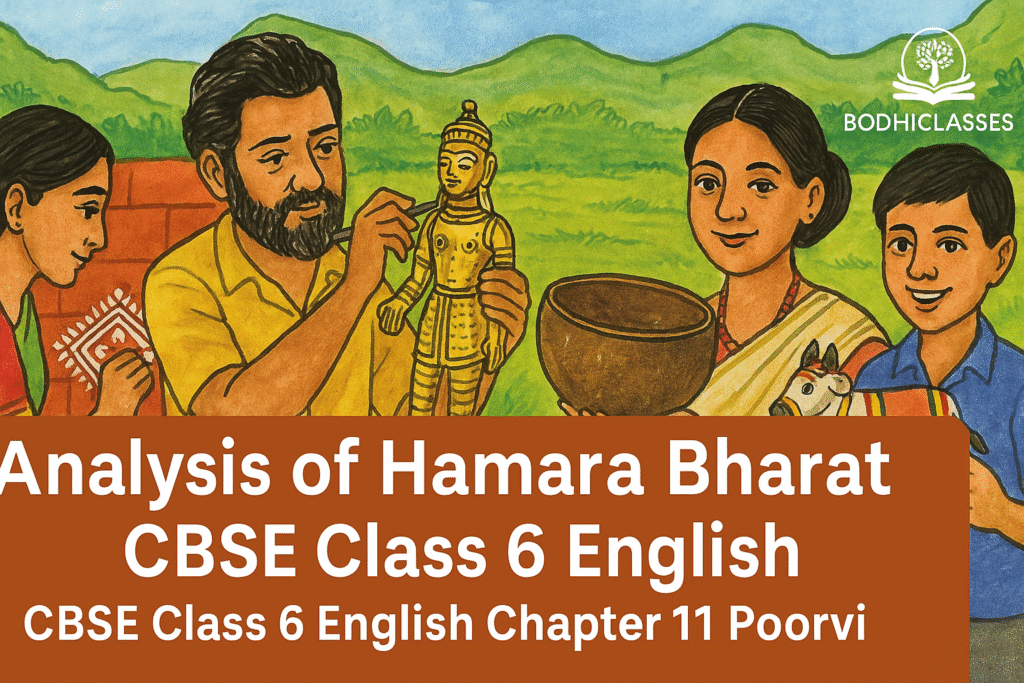Analysis of Hamara Bharat CBSE Class 6 English offers a deep insight into India’s cultural, traditional, and geographical richness. This chapter from the Class 6 English textbook Poorvi not only introduces students to India’s vibrant heritage but also promotes values like unity in diversity, mutual respect, and national integration. By exploring traditional art forms like Aipan, Dhokra, Coconut Shell Craft, and Kondapalli Toys, the chapter highlights the creativity rooted in different Indian states. It also emphasizes the importance of government programmes like Ek Bharat, Shreshtha Bharat in fostering cultural bonding and emotional unity. This analysis provides a detailed breakdown of the themes, values, and educational activities present in the chapter.

Analysis of Hamara Bharat CBSE Class 6 English Chapter 13 Poorvi

Main Points of the Chapter: Hamara Bharat – Incredible India!
1. Introduction to Bharat (India)
- India is known for its wisdom, bravery, and rich culture.
- It has attracted travellers from ancient times due to its diversity.
- The country is full of rivers, mountains, forests, and wildlife.
- People live in unity despite cultural and regional differences.
2. Ek Bharat, Shreshtha Bharat Programme
- A government initiative to promote cultural exchange between different states.
- Helps people learn about each other’s traditions, languages, and arts.
- Encourages national unity by celebrating diversity.
3. Traditional Art Forms of India
- Aipan (Uttarakhand) – Folk art drawn using white rice flour paste on red walls during festivals.
- Dhokra (Odisha) – A 4,000-year-old metal craft using clay, wax, and brass.
- Coconut Shell Craft (Kerala) – Creating decorative and household items from coconut shells.
- Kondapalli Toys (Andhra Pradesh) – Handmade wooden toys painted with natural dyes.
4. Cultural Activities in the Chapter
- Vocabulary Exercises related to Indian culture.
- Sentence Construction using sequencing words (first, then, after that, finally).
- Listening Activity – Understanding traditional foods like Gakkad Bharta.
- Speaking & Writing Tasks about local art forms.
5. Importance of Unity in Diversity
- India has many languages, customs, festivals, and traditions.
- Despite differences, all Indians share a common national identity.
- Respecting and preserving culture is essential for the country’s growth.
6. Conclusion: Role of Students
- Learn about India’s diverse culture.
- Respect and promote traditional arts and crafts.
- Work towards unity and national pride.
Message Imparted Through the Text: Hamara Bharat – Incredible India!
- Unity in Diversity: The text highlights that despite having numerous languages, traditions, and cultures, India remains united as one nation. This teaches students the importance of respecting and embracing diversity.
- Pride in Cultural Heritage: India has a rich and ancient culture, with unique art forms, crafts, and traditions. The text encourages students to take pride in their heritage and preserve it for future generations.
- Importance of Traditional Arts: Various art forms like Aipan, Dhokra, Coconut Shell Craft, and Kondapalli Toys are part of India’s identity. Learning about them helps in appreciating the creativity and craftsmanship of different regions.
- The Need for National Integration: The Ek Bharat, Shreshtha Bharat initiative promotes interaction between different states, fostering mutual understanding and strengthening emotional bonds between citizens.
- Responsibility Towards Nation-Building: As future citizens, students must contribute to the progress of the country by respecting its traditions, maintaining unity, and working hard for its development.
- Respect for Nature and Resources: The chapter emphasizes the connection between culture and nature, as seen in traditional crafts that use natural materials like clay, coconut shells, and plant-based colors.
Analysis of Hamara Bharat Cbse Class 6 English
Main Themes of the Chapter: Hamara Bharat – Incredible India!
- Unity in Diversity
- Despite having different languages, customs, and traditions, India remains a united nation.
- The Ek Bharat, Shreshtha Bharat initiative promotes national integration through cultural exchange.
- Cultural Heritage and Traditions
- India has a rich and ancient culture that needs to be preserved.
- The chapter showcases traditional arts and crafts like Aipan, Dhokra, Coconut Shell Craft, and Kondapalli Toys.
- Emphasizes how traditions are passed down through generations.
- Geographical and Natural Beauty
- India is blessed with rivers, mountains, forests, and biodiversity.
- Nature plays a significant role in shaping Indian culture and livelihoods.
- Pride and Patriotism
- Encourages students to take pride in India’s identity.
- Reinforces the idea that every citizen has a role in making the country better.
- Skill, Craftsmanship, and Sustainability
- Highlights the creativity and craftsmanship of different states.
- Many traditional crafts use eco-friendly and natural materials, promoting sustainability.
- Mutual Understanding and Respect
- Learning about different cultures helps in appreciating diversity.
- Encourages students to respect different traditions and backgrounds.
The Analysis of Hamara Bharat CBSE Class 6 English reveals how the chapter serves as a meaningful tribute to India’s diverse heritage. It educates students about the significance of traditional crafts, promotes a sense of national pride, and underlines the importance of respecting different cultures. Through engaging learning activities, the chapter fosters awareness, empathy, and responsibility towards preserving India’s legacy. It teaches young learners to become proud, informed, and active citizens who contribute to the country’s unity and development. For more insightful chapter analyses and learning materials, visit BODHICLASSES.COM.


